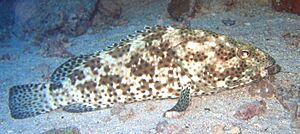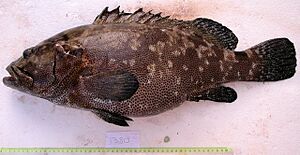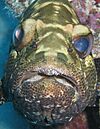Camouflage grouper facts for kids
Quick facts for kids Camouflage grouper |
|
|---|---|
 |
|
| Conservation status | |
| Scientific classification | |
| Synonyms | |
|

The camouflage grouper (Epinephelus polyphekadion) is a cool type of fish that lives in the ocean. It's also known by other names like the blue-tailed cod or snout-spot grouper. This fish is a kind of grouper, which belongs to a larger family of fish called Serranidae. This family also includes sea basses. You can find these groupers in many parts of the Indo-Pacific ocean, especially around coral reefs.
Contents
About the Camouflage Grouper
What Does It Look Like?
The camouflage grouper has a body that is about 2.7 to 3.1 times deeper than its length. The top of its head is rounded, and the area between its eyes is flat. It has a rounded gill cover with small bumps.
Its dorsal fin (the one on its back) has 11 stiff spines and 14 to 15 soft rays. The anal fin (underneath) has 3 spines and 8 soft rays. The fourth spine on its dorsal fin is longer than the others. Its tail fin is rounded.
This fish is usually pale brown with many small, dark brown spots. Its upper body is whitish, but it has large, dark blotches that look like diagonal stripes. There's also a dark, saddle-shaped spot near its tail fin. It can grow up to 90 centimetres (35 in) long! People sometimes confuse it with another fish called Epinephelus fuscoguttatus.
Where Does It Live?
The camouflage grouper lives in a huge area called the Indo-Pacific. This stretches from the coast of East Africa, including the Red Sea, all the way east across the Indian Ocean. You can find it around islands like the Comoros, Mauritius, and the Seychelles.
Further east, it lives in the Pacific Ocean, reaching places like French Polynesia. Its range goes north to southern Japan and south to Australia. In Australia, it's found from Shark Bay in Western Australia all around the northern coast to One Tree Island in Queensland. It also lives around reefs and islands in the Coral Sea and the Tasman Sea.
How Does It Live?
Camouflage groupers live in shallow waters in lagoons and outer reefs. They love areas with lots of coral. They are especially common around islands and atolls. They also like to hide in caves and cracks in the reefs.
These fish usually swim in small groups, but sometimes you might see one swimming alone. They prefer clear water. Camouflage groupers are predators, meaning they hunt other animals for food. They mostly eat crustaceans, like crabs, and other fish. Sometimes, they also eat cephalopods (like squid) and gastropods (like snails).
They can live for a long time, up to 42 years! They become old enough to have babies when they are about 4 years old. These groupers gather in large groups to lay their eggs, and they often travel along the same paths to reach these special spawning spots.
Naming the Grouper
The camouflage grouper was first officially described in 1849. A Dutch doctor and fish expert named Pieter Bleeker gave it the scientific name Serranus polyphekadion. He found the first known specimen in Jakarta.
Why Are They Important?
Camouflage groupers are valuable fish. In the past, they were commonly sold in fish markets in places like Zanzibar. Today, they are important in the international trade of live reef fish, especially in Southeast Asia, the western Pacific, and parts of the Indian Ocean.
Most of these fish are caught when they gather together to lay their eggs. The Philippines and Indonesia are major countries that export these fish. There's also a big fishing business for them in the Red Sea, off the coast of Saudi Arabia. Fishermen in Australia and Papua New Guinea catch them using hooks, lines, spears, and traps. Scientists are also trying to raise them in special fish farms, but it's still a challenge to do this on a large scale.



